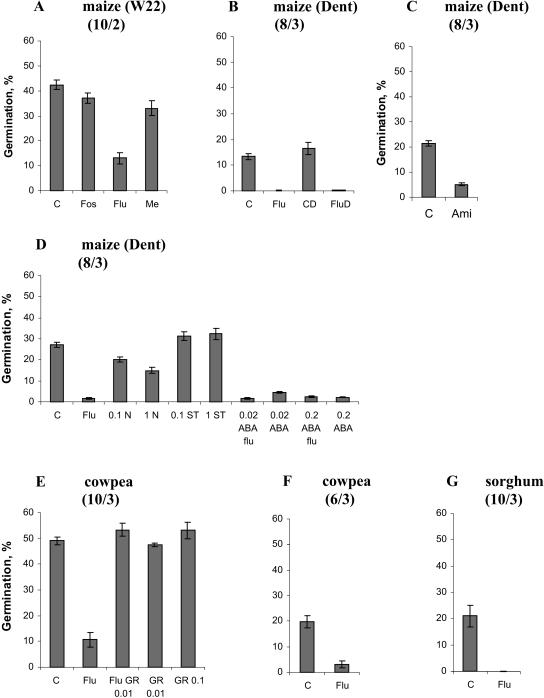Figure 5.
Germination of S. hermonthica seeds induced by root exudates of maize (W22 or Dent, as indicated in the graphs; A–D), cowpea (E and F), and sorghum (G) as affected by treatment of the host seedlings with (A) 100 μm fosmidomycin (Fos), 25 μm fluridone (Flu), and 10 μm mevastatin (Me) compared with untreated control (C). B, 10 μm Fluridone (Flu) applied to plants growing under normal light (Flu) and dim light (FluD) compared with their respective untreated controls (C and CD). C, 200 μm Amitrole (Ami) compared with untreated control (C). Seedlings were grown at 21°C. D, Untreated control (C), 10 μm fluridone (Flu), 0.1 mm naproxen (0.1 N), 1 mm naproxen (1 N), 0.1 mm sodium tungstate (0.1 ST), 1 mm sodium tungstate (1 mm ST), 0.02 mm abscisic acid and 10 μm fluridone (0.02 ABA Flu), 0.02 mm abscisic acid (0.02 ABA), 0.2 mm abscisic acid and 10 μm fluridone (0.2 ABA Flu), and 0.2 mm abscisic acid (0.2 ABA). E, 10 μm Fluridone and nontreated control (C), 10 μm fluridone (Flu), and root exudate of fluridone-treated seedlings combined with 0.01 mg/L GR24 (Flu GR 0.01) compared with 0.01 and 0.1 mg/L GR24 alone (GR 0.01 and GR 0.1). F, 10 μm Fluridone (Flu) on O. crenata germination compared with nontreated control (C). G, 4 μm Fluridone (Flu) compared with nontreated control (C). Within each experiment, the concentrations of root exudates were equalized, by dilution, for differences in root fresh weight. Data represent average germination ± standard error of 8 to 10 individual plants and two or three disks (indicated in each diagram by 8/3, etc.), with about 50 S. hermonthica seeds each per plant. Statistical analysis showed significant difference (P < 0.05) for all treatments, except the treatments with 100 μm fosmidomycin,10 μm mevastatin, and 0.1 mm naproxen.

